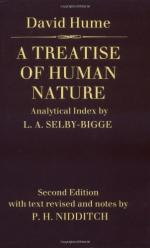It may not be amiss, in treating of the affection we bear our acquaintance and relations, to observe some pretty curious phaenomena, which attend it. It is easy to remark in common life, that children esteem their relation to their mother to be weakened, in a great measure, by her second marriage, and no longer regard her with the same eye, as if she had continued in her state of widow-hood. Nor does this happen only, when they have felt any inconveniences from her second marriage, or when her husband is much her inferior; but even without any of these considerations, and merely because she has become part of another family. This also takes place with regard to the second marriage of a father; but in a much less degree: And it is certain the ties of blood are not so much loosened in the latter case as by the marriage of a mother. These two phaenomena are remarkable in themselves, but much more so when compared.
In order to produce a perfect relation betwixt two objects, it is requisite, not only that the imagination be conveyed from one to the other by resemblance, contiguity or causation, but also that it return back from the second to the first with the same ease and facility. At first sight this may seem a necessary and unavoidable consequence. If one object resemble another, the latter object must necessarily resemble the former. If one object be the cause of another, the second object is effect to its cause. It is the same case with contiguity: And therefore the relation being always reciprocal, it may be thought, that the return of the imagination from the second to the first must also, in every case, be equally natural as its passage from the first to the second. But upon farther examination we shall easily discover our mistake. For supposing the second object, beside its reciprocal relation to the first, to have also a strong relation to a third object; in that case the thought, passing from the first object to the second, returns not back with the same facility, though the relation continues the same; but is readily carryed on to the third object, by means of the new relation, which presents itself, and gives a new impulse to the imagination. This new relation, therefore, weakens the tie betwixt the first and second objects. The fancy is by its very nature wavering and inconstant; and considers always two objects as more strongly related together, where it finds the passage equally easy both in going and returning, than where the transition is easy only in one of these motions. The double motion is a kind of a double tie, and binds the objects together in the closest and most intimate manner.




